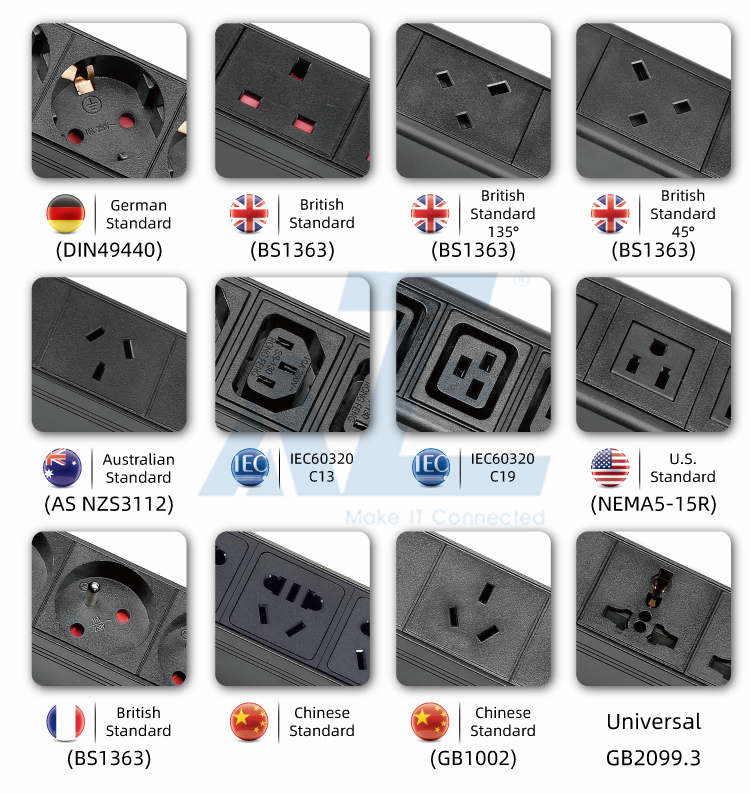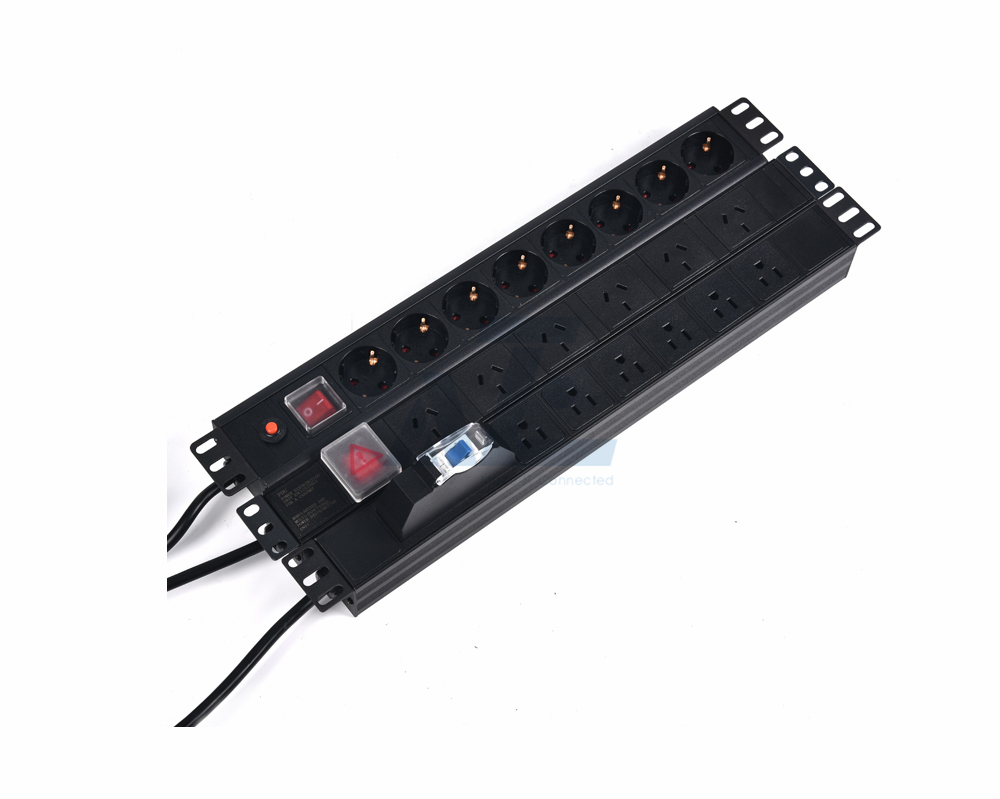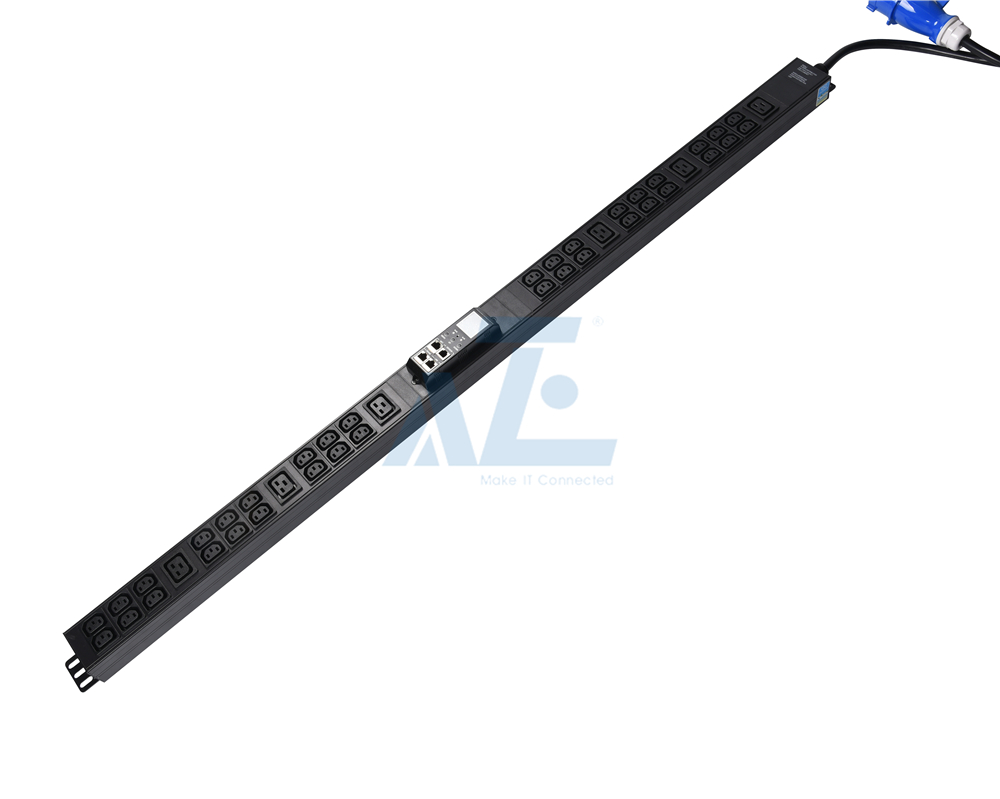Explore Data Center or Mining Power Solution with AZE !
- Single Phase , Three Phase
- Basic, Metered, Switched and Monitored
- Australia, IEC C13,C19, Italy, France, UK,Germany,USA Outlet...
Overview
A Power Distribution Unit (PDU) is designed for the specific purpose of powering multiple devices in a server rack or enclosure. A PDU distributes the available amperage evenly and efficiently among all outlets so that all connected servers, networking hardware, telecom equipment and other devices receive the best available power to maintain operation. PDUs are available in a variety of styles that provide everything from basic power distribution to enhanced remote power management.
The power distribution unit (PDU) is a device for controlling electrical power in a data center. The most basic PDUs are large power strips without surge protection. They are designed to provide standard electrical outlets for data center equipment and have no monitoring or remote access capabilities. More advanced PDUs provide real-time monitoring and remote access capabilities.
PDUs manage and distribute electricity and are normally installed directly onto a rack.PDUs are also be described as basic or intelligent, with multiple types of intelligent PDUs. These include the following:
- Basic pdu
- Metered
- Switched
- Switched PDU with outlet metering
| Product feature by Rack PDU by family/series | Basic | Metered | Metered-by-outlet | Switched | Outlet Metered,Outlet Switched |
| Design features | |||||
| Ultralow-profile, space-saving design | ✓ | ✓ | ✓ | ✓ | ✓ |
| Hydraulic-magnetic circuit breakers(in units configured with circuit breakers) | ✓ | ✓ | ✓ | ✓ | ✓ |
| Ultralow-profile circuit breakers (for units with breakers) | ✓ | ✓ | |||
| Locking IEC receptacles and locking power cord compatible | ✓ | ✓ | |||
| Environmental monitoring port for externaltemperature/humidity monitoring | ✓ | ✓ | |||
| Display and network management | |||||
| Full-featured network management capability via Web, SNMP, Telnet Two-digit, seven-segment LED display | ✓ | ✓ | ✓ | ✓ | |
| User-interactive LCD display for local access | ✓ | ✓ | ✓ | ||
| Field-replaceable network management module | ✓ | ✓ | |||
| Network port sharing (up to four Rack PDUs share one IP address in one enclosu | ✓ | ✓ | |||
| Local USB port for easy local firmware updates | ✓ | ✓ | |||
| Metering capability | |||||
| Active current measurements (amps) | ✓ | ✓ | ✓ | ✓ | |
| Active power measurements(including volts, amps, real power (kW), and energy ( | ✓ | ✓ | |||
| User-customizable alarms and warnings | ✓ | ✓ | ✓ | ✓ | |
| Embedded log memory to record/review/report historic metered data | ✓ | ✓ | ✓ | ✓ | |
| Individual outlet power metering | ✓ | ✓ | |||
| Outlet control | |||||
| Individual outlet remote power on/off control | ✓ | ✓ | ✓ | ||
| Power-on sequencing and time delays with full user customization | ✓ | ✓ | ✓ | ||
| Outlet level grouping (multiple outlets in same or multiple units follow singl | ✓ | ✓ | ✓ | ||
| User access control with assignable roles, access levels atdevice and outlet l | ✓ | ✓ | ✓ | ||
| Outlet grouping feature for synchronized control of outlets on multiple Rack P | ✓ | ✓ | ✓ |
Basic PDUs vs. intelligent PDUs
Power distribution units are categorized as basic or intelligent.Basic units only provide power distribution. The following two types are considered basic PDUs:
- Basic PDU. This is a power strip that distributes voltage and current to multiple outlets.
- Monitored PDU. This is a basic PDU that also displays electrical data.
Intelligent PDUs provide power distribution and other features, such as power metering, monitoring, remote outlet switching, remote outlet control and notifications of potential issues. Types of intelligent PDUs include the following:
- Metered inlet PDU. These metered PDUs determine power usage and available capacity of circuits, which makes it easier for equipment provisioning. They also help in calculating efficiency metrics and avoiding overloading a circuit.
- Metered outlet PDU. Metering done at the outlet helps users in determining both power usage and rack availability. This type of PDU enables users to make comparisons to determine if a device is energy-efficient.
- Switched PDU. These PDUs have the same features as metered inlet PDUs, but they also give users control over individual outlets and groups of outlets. The outlets can power devices remotely. And switched PDUs enable users to turn off devices when not in use, saving power.
- Switched rack PDU with outlet metering. A switched rack power distribution unit has the same features as a switched PDU with outlet metering.
Basic PDUs are ideal for simpler IT setups. However, an organization with a more complex environment likely needs intelligent PDUs.
Benefits of intelligent PDUs
Benefits that come with intelligent power distribution units include the following:
- Improved data center management. Intelligent PDUs include features that aid with data center management, such as metering and remote capabilities.
- Reduced energy consumption. Monitoring power consumption enables organizations to better gauge power usage. Devices can also remotely turn off outlets when not in use to save power.
- Better control over power. Remote toggle functions are available to control individual outlets.
- Energy consumption data. Intelligent PDUs can monitor energy use and provide data on where and how energy is consumed.
Custom PDUs
AZE builds custom PDUs for all applications.
- Power Configurations Choose any power configuration; single, dual, or three-phase with any voltage from 120V to 600V.
- Voltage Conversion Step up or step down any voltage with integrated transformers.
- Surge Protection Surge protection with MOVs (metal oxide varistors).
- Circuit Protection Protect mains and branch circuits with thermal or magnetic circuit breakers or fuses.
- Metering Get real-time metrics from onboard integrated LCD meters to show voltage, current, watts, temperature or frequency.
- Enclosure Styles Choose any enclosure style; 0U, rack mount, tabletop, freestanding, wall mount and more.
- Remote Control & Monitoring Control and monitor PDUs with Raptor Connect software. Turn outputs on and off and monitor sensors.
- EMI/RFI Filtering Ensure clean power with integrated EMI/FRI filters.
- Connectors Choose any connector type; NEMA, IEC, CS, MIL, Terminals and more.
AZE can build custom PDUs for all the data center or crypto mining applications! CONTACT US to get your custom project started today!
Application
Power distribution unit, also known as PDU, refers to a device fitted with multiple outputs designed to control and distribute electric power, which is normally used in the racks of networking equipment located in a data center.
According to different classification standards, the rack PDUs have various types for different applications: non-intelligent & intelligent PDUs, single-phase & three-phase PDUs, vertical & horizontal PDUs, etc.
- Reduce Energy Costs
Using PDU means running various outputs all from the same source. Thus it's much easier to channel the energy and avoid any unnecessary wastage.
- Provide Reliability for Power Loads
PDUs can help to link each socket to a computing or networking device so as to multiple integrated power outputs. Adopting a PDU solution will help to protect against data loss and downtime caused by a disconnected plug.
- Create an Organized Structure
Simply put, no more clutter. The optimal form factor takes up less space for efficient rack space utilization. Furthermore, the mass situation of hundred different wires running around leading to different places won't exist any longer. The PDU will be the central control hub of all the power outputs.
-
Offer Convenient and Flexible Installation
The rack PDUs are generally lightweight to mount. PDUs with color-coded circuits make it easy to identify phases to outlet banks to aid in fault isolation or load balancing. The rack PDUs are available in either vertical or horizontal formats and can be custom built to match specific power requirements from some vendors. Most of them are versatile and cost-effective to meet various network requirements.
A power distribution unit (PDU) is a designed to distribute electric power to equipment in a data center or networking center. Power is typically distributed to racks of computers or networking devices via multiple outputs on the PDU. The PDU performs a number of controls related to the distributed power such as AC power monitoring, power metering, environment sensing and monitoring, and is equipped with a LAN connection. ST offers a wide range of products suitable to cover the needs of power distribution units. These products include power management ICs, microcontrollers and a variety of environmental sensors.The PDUs are widely used in area:
- Data center
- Network rack
- Office
- Mining
- Electric
- Telecom
Options
For PDU receptacles, most of them follow with the NEMA standard set by the US National Electrical Manufacturers Association. The NEMA connectors including power plugs and receptacles are used for AC mains electricity in North America and other countries that use the standards.
The NEMA wiring devices are made in current ratings from 15 to 60 amperes (A) with voltage ratings from 125 to 600 volts (V). The number follows the hyphen means the current rating of the device, while the letters have different meanings—R stands for "Receptacle" while P represents "Plug," and L indicates locking (receptacle or plug). For example, the 5-15R is the common 125 V two-pole, three-wire receptacle rated for 15 A. Sharing the same electrical rating, the L5-15R is a locking design that is not physically compatible with the straight-blade 5-15 design. And the 5-30R has the same two-pole, three-wire configuration and 125 V rating, but is rated for 30 A.
Every rack PDU provides a certain number of receptacles/outlets that vary based on the physical size (i.e. the length, width, and depth) of the PDU, as well as the total space available and the power handling capacity of the PDU. For instance, a 1U rack-mounted PDU has enough space to handle eight 120V/15A NEMA 5-15R outlets. And a 2U rack-mounted PDU that is larger with more available space and can handle greater power consumption levels might be able to support twenty 120V/15A NEMA 5-15R outlets.
Set by the Electrotechnical Commission (IEC), IEC 60320 is another standard that specifies non-locking connectors for connecting power supply cords to electrical appliances. The voltage should not exceed 250 V (a.c.) while the rated current should not exceed 16 A. C13 and C19 standard outlets are equipped with the cord locking system in order to avoid accidental disconnections, which are commonly found on servers, routers, and switches. C14 plugs for C13 and C20 plugs for C19 is a universal compatible solution.
Here are the figures of some commonly-used receptacle types:

Here are the figures of some commonly-used plug types:
Buying Guides
How to Choose a PDU for Your Network or Data Center
These are the top 6 factors to consider in your buying decision:
1. Horizontal vs. Vertical Installation
PDUs can be mounted horizontally or vertically inside or outside the rack enclosure:
Horizontal PDUs are installed in the rack and take up one or two rack spaces (1U-2U). Because of their smaller size, horizontal PDUs have fewer outlets.
Vertical PDUs can be mounted on the back or side of the rack enclosure. Deep racks will often leave space for vertical PDUs to be mounted inside the enclosure. Vertical PDUs can have up to 40 outlets.


2. Voltage of Your Connected Equipment
In North America, the voltage used to power servers and networking equipment is typically 120V or 208/240V.
Europe and Asia typically provide 230V power.
Be sure that the PDU input plug matches the receptacles of your input power source.
3. Outlet Types
The PDUs outlets should match the plugs on the equipment you'll be connecting.
4. Number of Outlets
Select a PDU with more outlets than the number you need to ensure room for future rack growth.

5. Maximum Output Capacity
The total power required by equipment connected to the PDU must not exceed the PDU's maximum load rating (expressed in kVA). In North America, the maximum input and output capacity is limited to 80% (this is referred to as “agency de-rating”). For example, a single-phase PDU with a nominal voltage of 120V and de-rated input current of 12A (80% of 15A), has a load capacity of 1.44 kVA (120V x 12A).
6. Special Features
FAQ
What is a Power Distribution Unit (PDU)?
A Power Distribution Unit (PDU) is a device with multiple outlets designed to distribute power to computers, servers, network switches and other it devices in a rack. PDUs come in a variety of styles that provide everything from basic power distribution to enhanced remote power management.
Choosing a PDU
Before installing a power distribution unit, an organization must decide on the type of PDU it needs. Specs to look at and questions to ask vendors and distributors when making this decision include the following:
- Where is the PDU being installed? Will it be mounted on a rack, placed on the floor or in a cabinet? Or does it need to be portable? Is it being mounted vertically or horizontally?
- What type of input power is needed? Is it AC power or DC? Is it rated for the common voltage -- 120, 240 or 330 volts -- used in the organization's country?
- How much power does the equipment need? The total power needed by equipment connecting to the PDU cannot exceed the unit's maximum load rating.
- How many outlets are needed? A PDU with more outlets than needed should be chosen in anticipation of future needs.
- What sort of plugs are needed? Some PDUs may offer a mix of outlet types to match the plugs on the various devices that connect to them.
- Are other features needed? Organizations with complex environments likely need in-depth monitoring, which requires an intelligent PDU. The specific type depends on the features an organization needs.
Installing a PDU
The specific steps involved in installing a power distribution unit may differ depending on the type of PDU. A general installation of a rackmount PDU includes the following steps:
- Align vertical-mounting brackets.
- Attach the brackets to the PDU.
- Connect the power cord.
- Route and secure the cord to its power source.
- Secure the power cord with cable straps.
- Connect the servers or rack devices to the outlets on the PDU.
Related Article
Get A Quote
While we strive to create custom products, please note that not all requests will qualify for a free prototype. Determination will depend on your project needs, quantity, and a final management review.
Let's get started, we are ready to work with you! Fill out the information below to send in your request and requirements and our team will be in touch shortly.






